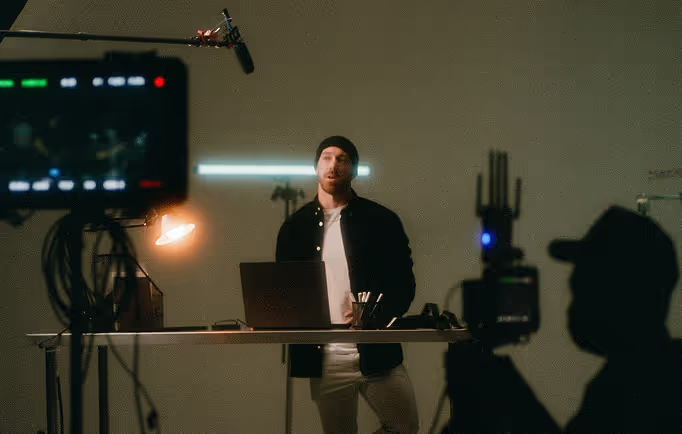Explainer Videos Are Helping Businesses Adjust To A Shifting Talent Pool – Here’s How

You may or may not have noticed, but there have been a few teensy changes in the world over the last few years. Alongside the pandemic we have seen shifts in the way people go about their day, and the way people view their time, their health, and their money. Businesses have had to pivot, persist, or pack up. As a result, expectations on workers have changed – and so too have the workers themselves. Businesses are starting to realise we are in the thick of a shifting pool of talent, and there are a few main themes that are emerging in the form of remote work, the gig economy, and social media as a job seeking hub.
The way we work is changing – but thanks to explainer videos, we can prepare ourselves for a pain-free pivot.
1) The rise of remote work
If there’s one thing the ol’ pandemic has gifted the workforce with, it’s making work from home a reality for many more industries than previously thought possible.
Research from survey firm McKinsey reveals that in 2022, 58% of Americans were allowed to work from home at least one day a week, and huge 35% reported having the option to work remotely all week. These responses spanned across all different industries and economic sectors, including traditionally blue collar and white collar jobs (https://www.mckinsey.com/industries/real-estate/our-insights/americans-are-embracing-flexible-work-and-they-want-more-of-it).
This new reality has opened up a wealth of opportunities on both sides of the employment spectrum. For employees, it means expanded options on where to live, plus money and time saved on commuting. And for employers, it means the talent pool is becoming wider, more diverse, and increasingly global. Business owners are no longer limited to fishing in their own backyard pool when looking for the best talent. In some ways, the increased options for talent sourcing can become overwhelming without borders, and the idea of recruitment out of state, or even out of country, can seem like it’s hardly worth the hassle.
This is where explainer videos are a beacon of help. By developing short, effective video content as a hub for recruitment, brands can pitch their company values, style, and work culture across multiple online platforms no matter where in the world their future employees are.
2) The rise of the gig economy
As kitschy as the phrase ‘gig economy’ is, its relevance in the wider workforce is stronger than ever thanks to the pandemic’s influence in shifting our mindset of work/life balance. With a huge number of layoffs in some industries, and the forceful overworking of staff in others, workers have become disillusioned with the traditional structure of full-time employment. Instead, more and more people are turning to gigs – that is, temporary, freelance, independent contract work – as way to gain flexibility and control of their work schedule. Over a third of US workers take part in gig work as their main or secondary job, and this number is projected to increase to over half in the near future (https://fortunly.com/statistics/gig-economy-statistics/). All in all, the gig economy is proving to be very real, and increasingly the way our future workforce could be run.
What does this mean for businesses searching for talent? For one, a workforce based around freelancers often points toward shorter term contracts, less lifetime company loyalty, and potentially more of a revolving door culture for staff. This inevitably means more hiring and rehiring, more staff training, and more explaining who your brand is and why you’re worth working for. Training staff who operate on their own schedule can be a scheduling nightmare.
Using pre-prepared video content for hiring and training purposes is a massive time saver, allowing each contractor to learn the ropes at their own pace and schedule. Without the costs or time restrictions of in-person training, video delivers a great return on investment when it comes to training gig workers, especially if your team is spread across multiple timezones. And explainer videos help new hires learn and retain information more effectively – firstly by transforming dry content into an entertaining video, secondly by simplifying complex ideas into a short, efficient format, and thirdly by being an on-demand learning tool, so staff can revisit the material whenever they need a refresher.
3) The rise of social media as a source of job seeking
An emerging trend of the last decade is seeing talent looking for work through social media websites over traditional sources job ads. This is especially true for media, tech, and creative sectors, where visual portfolios of work, links to past projects, and connections with big name clients really count for a lot. With employees and brands alike being expected to use their online presence as a portfolio, it’s important to share quality content that will attract the best talent for your brand. Advertising yourself with explainer videos that will hit the big metrics on a range social media platforms (that is: short, entertaining, and informative) is a move that aims to genuinely connect you with the best talent for your business while also boosting your online visibility and SEO.
Currently, video is the favoured medium of most major social media algorithms. With few exceptions, long gone are the days of chronological content. Instead, feeds are generally curated by algorithms, pushing up content that is deemed to be ‘highly interactive’ – for this, think of the kinds of posts that can offer valuable user data to the site and/or advertisers: popular posts with a large amount of shares and comments, ad content containing trackable buttons, and video content which can be metrically measured for popularity by how long you keep watching.
In our increasingly digitised work environment, these shifts to social media as a one- (or multi-)stop shop for talent sourcing make sense. Word spreads faster and content gets closer to the people you’re really trying to reach. Users are doubly likely to share video with their friends than any other content, and 73% of people say they’d rather learn about a new thing from short video than any other format (https://www.wyzowl.com/video-marketing-statistics/).
Despite this compelling evidence, many businesses still shy away from using video content on social media, with the most popular excuse (at 23%) being that they lack time (https://www.wyzowl.com/video-marketing-statistics/#stat-1-3). If this sounds like you, working with a video production company offers the best of both worlds, allowing professionals to produce custom content for your business while you keep the time to focus on what you do best.
Start a






